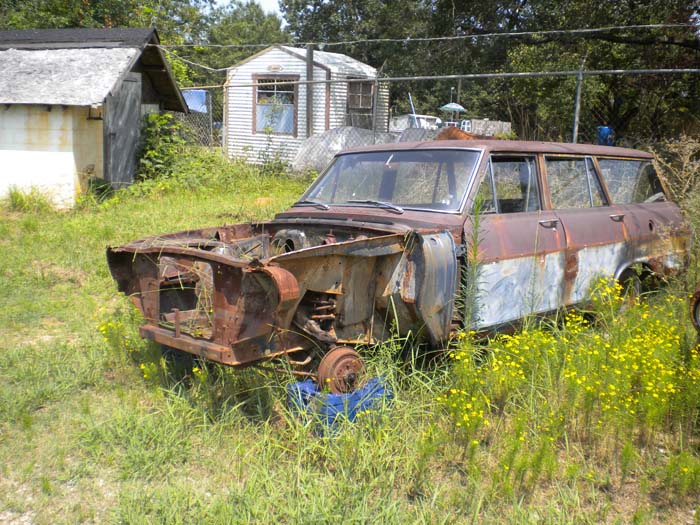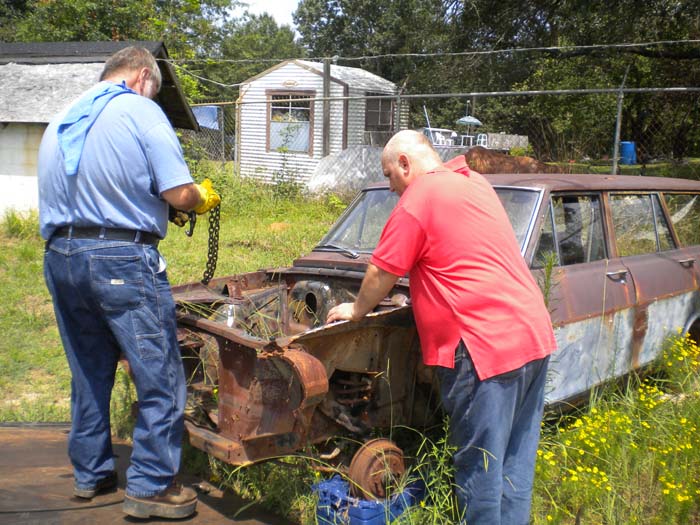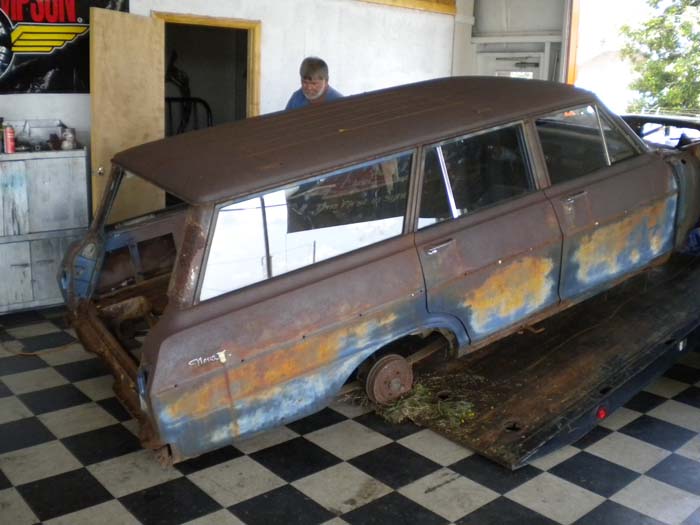PROJECT WHITE WAGON: GETTING THE CAR ON THE JIG
 What do you do to prepare a junkyard-purchased classic for drag strip competition?
What do you do to prepare a junkyard-purchased classic for drag strip competition?
That is the challenge Tom Lukans of TL Race Cars faces in the second installment of Project White Wagon.
The goal is to turn a 1964 Chevy II Wagon into a competitive SS/E Modified entry complete with a high-winding small block and manually shifted five-speed transmission.
Competition weight will require the car to tip the scales at 3,350 pounds with a 292-inch engine.

What do you do to prepare a junkyard-purchased classic for drag strip competition?

That is the challenge Tom Lukans of TL Race Cars faces in the second installment of Project White Wagon.
The goal is to turn a 1964 Chevy II Wagon into a competitive SS/E Modified entry complete with a high-winding small block and manually shifted five-speed transmission.
Competition weight will require the car to tip the scales at 3,350 pounds with a 292-inch engine.
We’re going old school all the way in preparing the car. There’s no special body in white, no trick kit or anything of that nature. There’s only this weather-beaten Chevrolet once driven by a house painter in the late 1960s and 70s.
The car was purchased from Tim Minton’s auto salvage company in Pacolet, S.C.
“The gentleman is no longer living and the engine in the car went bad, so he came over and sold it to me for scrap,” Minton recalled. “It sat down there in the junkyard for a long time.”
Seeing one of his junkyard cars make its way to the dragstrip is nothing new for Minton.
“We had an English Ford become a drag car and even a 1969 Camaro that ended up a Modified Production,” Minton added.
a d v e r t i s e m e n t
Click to visit our sponsor's website

The Chevy II wagon was years away from becoming a real-life tree-house as a tree had taken root underneath the passenger side.
Minton and his crew removed the car from the yard and delivered it to TL Race Cars.
From there, the car was mounted on the jig for the initial inspection.
“The second thing we did, after we prepared the car, was to square it up on the jig and nail it down to the jig and get the body rigid so we could start designing and fitting the infrastructure of the chassis into the car,” Lukans explained.
The car underwent a thorough cleaning to remove the extra ballast such as gobs of grass, dirt and a few spare parts found from other cars.
“We started stripping off the unnecessary components, such as the interior, roof rack, moldings,” Lukans explained. “We stripped the car down to the bare shell.”
That process took almost fourteen days to complete in-between Lukans’ other jobs.
“There were a lot of things that had to be air chiseled off just, because of the age of the car,” he added. “There is a reason why people aren't building cars of that age anymore, today, just because there are so many things that are old on these cars that have to be taken off. And some of it had to be taken off with care so we didn't damage some of the other items.”
a d v e r t i s e m e n t
Click to visit our sponsor's website

The car may require 3,350 per the rulebook but our goal is to dip well below that weight. We’re looking at 3,000 pounds in an effort to jump between classes just like Fulton used to do back in the day.
“We've taken off every screw, nut and bolt, every possible bracket that is not needed, that GM put on,” Lukans explained. “Now that we are building a race car that stuff is not needed.”
Lukans’ goal is to shed 350 pounds from the current body.
The current body is going to need some work but is in otherwise pretty good shape for serving as a haven for copperheads and ‘o possums for the last two decades.
“The outside shell of the body, which is the main part that we are most concerned with, that was in very good shape dent-wise and such,” Lukans said. “Time had passed it up from sitting outside. But, in general, it's still a solid, solid piece. What we've done, is we've cut the floors out of it and we have to put the original steel floors back in as per the rules. We're going to put in just what is required, minimally, and finish it off with regular sheet metal and do a nice job.”
The floors will have to come from an aftermarket source since the originals were rusted out.
“If you get an old car you are going run into the same problem,” Lukans confirmed. “With the undercoating and stuff on these cars, it's just not cost effective to take something like that off an old car. You still need some of the edges and corners that you just aren't able to take off an old car.”
If you look at the pictures of Fulton’s original White Wagon, you’ll notice the door-handles missing from the second set of doors. That was a necessity to gain the feel of the original wagon.
“That was the first thing we took off,” confirmed Lukans. “We're required (by CompetitionPlus.com) – rear door handles to be off. We are going to shave the body clean and that should satisfy the rules. On the inside (we'll have latch mechanisms). The front doors will still have the functional door handles. Just the rear door won't. And, that little door handle is not going to make any difference on the car. It's just a nostalgic thing for Gene Fulton, in his honor.”
PART 3, INSTALLING THE REAREND, PREPARING THE INTERIOR
PAST INSTALLMENTS
* Part 1, Outlining The Project

PROJECT WHITE WAGON SUPPORTERS
TL Race Cars (864) 427-5269
Fluid Power Specialties (864) 599-1118
Minton's Wrecker Service (864) 474-2581
Fulton Competition
PART SUPPLIERS
A.E.D. Motorsports Products (tubing)
Applied Racing Technologies (A.R.T)
Aeromotive Inc. (fuel system)
Autometer Guages (tech, engine gauges)
Bill Miller Engineering (rods, pistons)
Browell Bellhousings (bellhousing)
CFE Heads (cylinder heads, intake)
CFM Composites (seats)
Carson's Nut-Bolt and Tool
Comp Cams (camshaft)
Dart Engineering (Engine Block)
Flatout Gaskets (engine gaskets)
Hedman Headers (headers)
I.R.C. (wheelie bar wheels, bracketry)
Jegs Mail Order (misc.)
J&W Nova Parts (body panels and body sheetmetal)
Liberty's Transmissions (Transmission, Gears)
Matco Tools - (tools, tool box)
Mickey Thompson Tires & Wheels (front tires, slicks)
Moroso Performance (valve covers)
QA-1 (Rod Ends)
Quartermax Racing & Chassis Components (suspension, chassis components, axles)
Ram Clutches
Santhuff Shocks (front, rear shocks)
Simpson Safety - (Helmet, Firesuit)
Strange Engineering (Axles, Rearend companents)
Weld Racing (front, rear wheels)
Winberg Crankshafts (crankshaft)






































